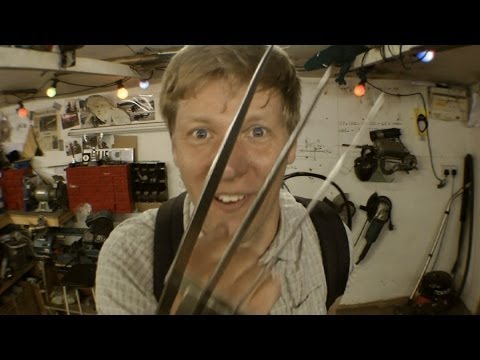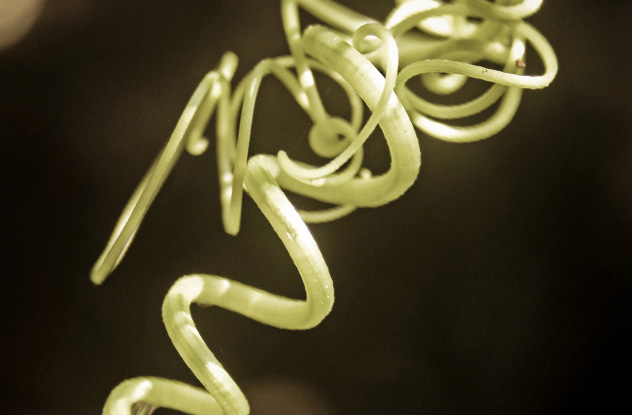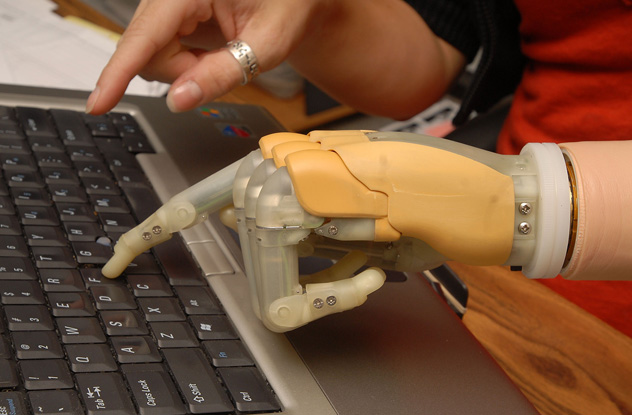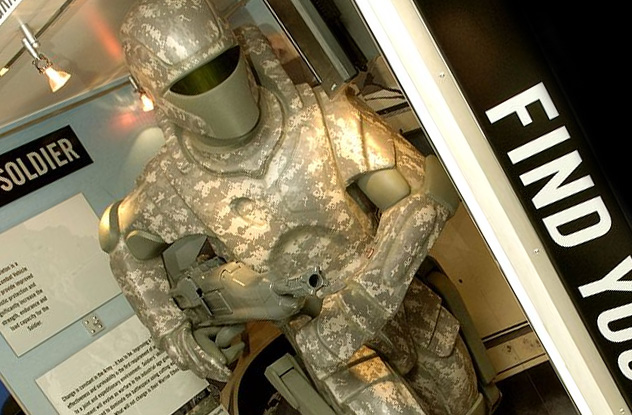Here are 10 comic book heroes that could exist now, or sometime in the future. (Some of these examples are reaching, but that’s inevitable. Otherwise, we’d currently have superheroes.)
10Cyclops
Cyclops, one of the leaders of the X-Men, shoots a powerful beam of energy from his eyes. This sounds like pure science fiction. However, a pair of physicists at Massachusetts General Hospital have altered human cells so they can emit light of their own. The team altered human kidney cells to produce the green fluorescent protein that makes jellyfish glow. The illuminated cells are easier to track, which has implications for cancer treatment. The researchers said that this could lead to people shooting beams out of their eyes. Sadly, it would probably be more like a flashlight than a death ray.
9Swamp Thing
Alec Holland was a scientist secretly working in the marshes when a bomb in his lab detonated. Instead of killing him, the blast turned him into Swamp Thing—a half-plant, half-man hybrid. He has super strength and the ability to communicate with plants. While communicating with vegetation and getting super strength from plants may not be possible, one thing that is theoretically possible is having a human-plant hybrid—specifically, humans getting energy from the Sun via photosynthesis. Most animals, including humans, do not use photosynthesis to get energy. However, scientists have recently discovered a small group of animals that do. Such animals include the pea aphid and the oriental hornet. The only vertebrate to use photosynthesis is the spotted salamander. In 2011, a synthetic biologist from the University of California injected the embryos of zebra fish with photosynthetic bacteria. Though the fish didn’t start photosynthesizing, they accepted the bacteria as the animal developed. This gives hope to other organisms, even humans, perhaps one day accepting such bacteria and using them. However, humans would still need leaves or some similar organ to maximize how much energy they get from the Sun. To absorb solar energy, whether as a plant or using solar panels, you need a large, flat surface. Humans simply aren’t shaped that way. So while it is theoretically possible to become more plant-like, it would be a terrible superpower to have.
8Captain America
When World War II broke out, Steve Rogers wanted to fight the Nazis. He was a small, weak man, but he had a big heart. So he was chosen for the Super Solider project and was injected with a serum, making him into the strong and powerful Captain America. It’s not actually possible to grow taller through drugs as Steve Rogers did. Bones simply cannot grow like that. However, it is possible to become taller through painful surgery. Doctors break the bones and implant telescoping rods that stretch the bones apart at the rate of 1 millimeter (0.04 in) per day. One man managed to grow 15 centimeters (6 in) after two surgeries. Besides growing taller, Rogers also got much stronger from just one injection, which is possible. A team at the Research Institute at Nationwide Children’s Hospital in Columbus, Ohio developed a shot that will increase muscle mass with a single injection. The shot uses a virus that codes the protein follistatin, which suppresses a gene called myostatin that stops muscle growth. The project’s lead researcher calls myostatin “brakes” and says the virus he created would simply let up on the brakes. The shot is for patients who suffer from muscular diseases. Growth does not happen exactly the way it does in the comic, in a matter of moments. Instead, these muscles grow for six months. While this particular shot does not allow for super soldiers in the immediate future, it does show that muscle growth from one injection is a real thing.
7Wolverine
Wolverine is known for a few things. The first is his incredible healing power. Second is his skeleton, which is enhanced with the nearly indestructible metal adamantium. Finally, he has retractable claws. A researcher at Harvard has accidentally come across a gene that could help with rapid regeneration. While doing cancer research, he punched holes in the ears of mice engineered with a gene that renews stem cells. A short time later, the holes in the ears had healed themselves, so he clipped their toes. Soon, the toes grew back. The gene may help with rapid regeneration. Other scientists are looking to bond organic materials and metals together. Two researchers at Max Planck Institute of Microstructure Physics in Halle, Germany have developed a process called atomic layer deposition. They shot beams of iodized metal into the silk string from a spider. Some of the metal embedded itself inside the organic string. This process could be used to strengthen bones. Adamantium is still a fictional compound. However, researchers are developing increasingly strong metals. In 2008, North Carolina State University developed an iron alloy from nanoscale crystals that is stronger than any other alloy, and it maintains its shape at a very high temperature. Finally, retractable, internal claws may be hard to create. However, people like YouTube host Colin Furze have had some fun making their own external claws.
6Spider-Man
How Peter Parker became Spider-Man is one of the most well-known origin stories in the history of comic books. A radioactive spider bit him, changing his genes, and he gained new powers, including superhuman strength and the ability to climb walls. To start off, is it possible to have your genetics altered by a spider? Theoretically, you can, but it’s quite unlikely. The spider would need to infect the subject with a retrovirus, which carries genetic information. The genetic information would then have to alter the DNA in cells. Almost every cell in the body would have to be infected. Even then, it would have to increase actin and the myosin proteins. These proteins effect muscle contractions, and an increase would theoretically make a person stronger. If the change in DNA gave the individual spider-like hairs on their hands and feet, then it might be possible for them to climb walls, but the person’s hands and feet would be hairy all the time. These hairs could also account for Spidey’s sixth sense, but he would only feel vibrations and changes in air pressure nearby. A possible alternative to hairy hands and feet is to use DARPA’s “Gecko Paddles.” Based on the way geckos climb, these paddles stick to surfaces and allow people to climb vertically. Right now, these paddles are awfully big due to the weight of humans and are still in trials. The last aspect of Spider-Man (at least in the Sam Raimi films) that makes him so unique is his ability to shoot spiderwebs. Spider silk is incredibly complex and evolved over millions of years. The human body simply doesn’t have the proteins needed to recreate it, so we would need a major biological change beyond what a retrovirus could do. However, if someone were to shoot spiderwebs from their wrists, the webbing would be strong enough to allow them to swing about. Spiderweb silk is five times stronger than steel of the same diameter. In the comics, Peter Parker develops a web shooter that is attached to his wrist, which is possible. German inventor Patrick Priebe made a web shooter of sorts using an electromagnet. Also, a team led by Uri Gat at Hebrew University in Jerusalem developed a genetically engineered spiderweb fiber. Perhaps it’s just a matter of time before these two inventions come together.
5Groot
Groot is a large treelike being who can feel, walk, listen, and talk (though his vocabulary is a bit limited). This isn’t total fiction. Plants on Earth have senses—for example, they know when they are being touched. They also have a sense of space, which keeps most plants from sprouting if planted upside down. They feel vibrations, allowing the plant to go into a defensive mode. In fact, plant specialists believe that animals and plants are very similar when it comes to sensation because they both go through a chemical process when they react. The one thing that Groot does that no real plant-animal hybrid could is walk or move quickly. Plants do move, like when they grow toward sunlight, but because of the way their cells are structured, they simply cannot form muscles. Being responsive to stimuli and but immobile is a far cry from being Groot. However, Groot’s an alien, and those constraints only apply to Earth plants. On alien planets, plants may think on their own. These thinking plants needn’t be rooted to the ground, either. Animals developed the ability to think so they could find food, so if the plant developed the ability to think, it might become a thinking, walking plant—just like Groot.
4Aquaman
Growing up on land, Arthur Curry thought he was just another boring human, until he learned that he was the true king of Atlantis. He had two notable powers: the ability to breathe underwater and to communicate with sea life. Communicating with all sea life is a bit of a stretch. However, some fish do communicate with each other through vibrations in the water. Also, for decades, researchers have been trying to communicate with dolphins. These smart and social animals use “signature whistles” to communicate with each other. Scientists are trying to create artificial whistles to talk with dolphins, so communicating with ocean life is certainly something scientists are striving for. The other main power of Aquaman is that he breathes underwater. Amazingly, in 2014, scientists developed a substance that one day may allow humans to do just that. At the University of Southern Denmark, scientists have developed a crystal substance from the element cobalt. The crystal absorbs oxygen and then releases a tiny amount repeatedly when heated. The crystal, called “ Aquaman Crystal,” is quite powerful. For example, a bucketful would absorb all the oxygen in a room. So if a diver wanted to forego scuba gear and use the crystals, they would only need a couple of grains. While it will be a long time before divers can use the crystal, the scientists behind it are confident that it will be used to replace scuba tanks in the future.
3Cyborg
First introduced in 1980, Vic Stone was a star athlete until he was in a horrible accident. His scientist father replaced more than half of his body with cybernetic parts. Using these parts, he gained superhuman strength and could tap into computers using his mind. Although he was invented over 30 years ago, Cyborg is one of the most realistic superheroes. For example, cybernetic limbs now fuse with nerves and the human brain, letting the user move naturally. Targeted muscle reinnervation surgery uses muscles that send messages between the brain and the artificial limb. It is estimated that 50 percent of the human body can, or will, be available for upgrade in the near future. The other feature that sets Cyborg apart from other mere mortals is his ability to use his mind to tap into computers. This ability is also starting to become a reality because researchers at the University of Washington have been able to transfer thoughts electronically. They attached electrodes to two subjects’ scalps. The subjects played a game; one person had a keyboard and the other didn’t. When a target came up on the screen, the person without the keyboard thought to press the “fire” button, and the other participant’s finger involuntarily hit the space bar to fire.
2Iron Man
Parts of the Iron Man suit are complete fiction. A suit wouldn’t be able to fly vertically, it wouldn’t have Repulsor Beams, and it wouldn’t have an arc reactor. However, consider Raytheon’s XOS 2 exoskeleton suit. So far, the exoskeleton lets you carry 90 kilograms (200 lb) without fatigue. Other exoskeletons in development will let you run faster, jump higher, and climb better. The final aspect that makes Iron Man such a dominant hero is that the suit is tough. This is more like the Tactical Assault Light Operator Suit (TALOS) being developed by the US military. The suit will be equipped with a computer that gives the wearer battlefield information, monitors vitals, and stops severe bleeding. That is, if the bullet can penetrate the suit, because it is expected to be bulletproof from top to bottom. The TALOS suit is expected to be ready for combat in 2018.
1Batman
Batman should be the most likely superhero to exist because he doesn’t have any real powers. But it’s a bit more complicated than that if you look at the finer details of the Caped Crusader. First off, Batman and Bruce Wayne would have problems co-existing. If Batman were going into physical fights every night, it would be exhausting; he’d need to sleep all day and would have problems running Wayne Enterprises. As for his gadgets and living the Batman lifestyle, a moneylending website estimated how much Batman would have spent after Batman Begins and The Dark Knight. By their calculations, Batman would spent $648 million, plus yearly costs of maintaining that lifestyle, like maintenance, fixing gadgets, and paying Alfred’s salary. On top of being super wealthy, Batman is incredibly smart. What type of education would someone need to reach Batman’s level of sophistication in chemistry, forensics, engineering, and computer programming? Let’s say he fast-tracked each degree and did them in two years. He’s still looking at a minimum of eight years of school. He would then have to stay up to date with each field and be innovative as well to make and maintain his gadgets and tools. So if some well-educated billionaire did decide to become Batman, let’s look at his physical strength and skill. He would need to train in speed and martial arts and be one of the best fighters in the world. Also, Batman doesn’t kill anyone, so he would need a tremendous amount of control on top of his skill. Add on the training with the bat suit and you’re actually looking at almost 20 years of physical training. After all that, Batman’s career would only last a few years—if you take into account all the injuries he’s likely to sustain. By some estimates, it could only be about two or three years long. So while Batman does not have any superpowers, for him to exist in real life, he would need to excel at different education disciplines, have hundreds of millions of dollars, and be as physically able as a professional athlete. Even then, his crime-fighting career would end almost immediately. Robert Grimminck is a Canadian crime-fiction writer. You can follow him on Facebook, on Twitter, or visit his website.
























